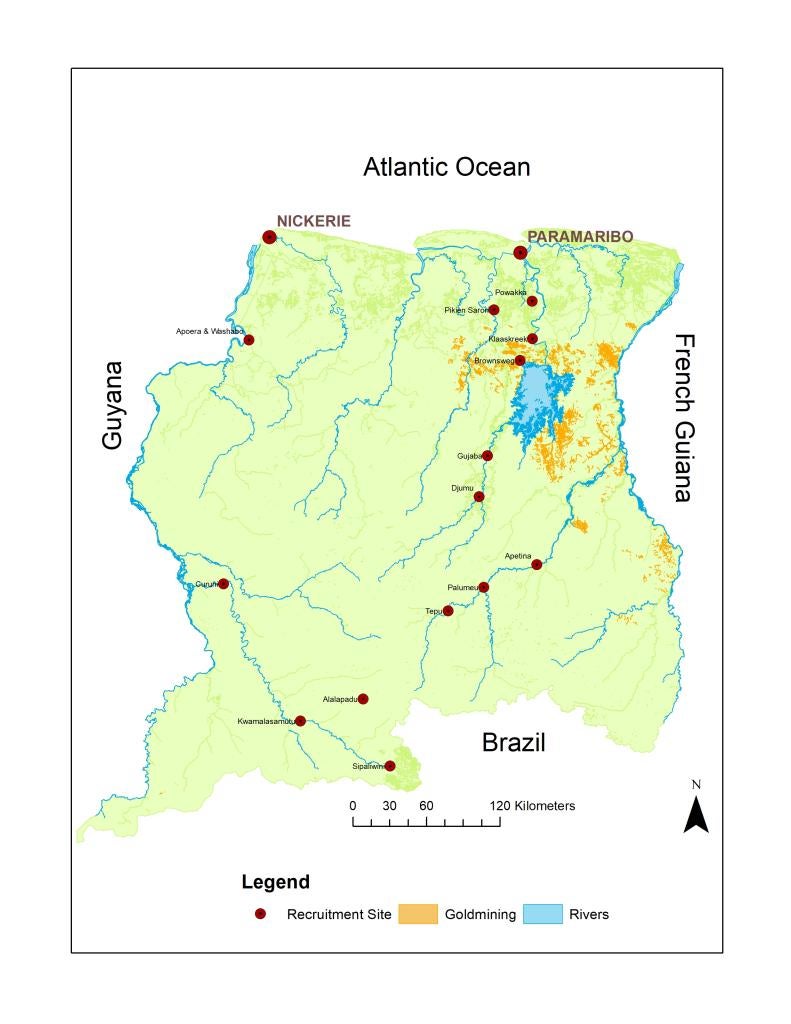The Caribbean Consortium for Research in Environmental and Occupational Health (CCREOH) prospective environmental epidemiologic cohort study (U01) addresses the impact of chemical and non-chemical environmental exposures on mother/child dyads (n=1200) in Suriname. The study determines associations between levels of environmental elements and toxicants in pregnant women, and birth outcomes and neurodevelopment in their children. Environmental assessments include fish, produce, rice, and sediment. In Suriname, the study is called MeKiTamara, which means “mother’s and child’s future” in Sranan Tongo.
The study addresses two high-priority public health threats in Suriname and neighboring countries in the Guiana Shield: the impact of mercury exposure from artisanal gold mining and pesticide exposure associated with agricultural practices in two vulnerable subpopulations: pregnant women and children younger than 5 years of age.
The aims of the U01 project are to:
- Identify exposures to a complex mixture of developmental neurotoxicants including mercury, arsenic, lead, and selected pesticides through comprehensive dietary, environmental, and occupational risk assessments, and biomarker monitoring in pregnant women, and their offspring.
- Assess the levels of key developmental neurotoxicants in environmental exposure sources including fish, produce, rice, and nutriceutical compounds and the impact of historical climate change on the deposition, accumulation and bioavailability of these neurotoxicants.
- Determine the association between child birth outcomes and levels of key developmental neurotoxicants in urban and rural pregnant women in Suriname and the impact of mobile health technology-enabled community health workers on this association and psychosocial health.
- Determine the association between prenatal, dietary, and environmental levels of key developmental neurotoxicants and neuroprotective nutriceuticals and longitudinal neurodevelopmental and epigenetic outcomes in infants and children 0-4 years of age living in rural and urban regions of Suriname.
- Disseminate research findings through a technology-driven environmental and occupational health awareness, education and research training framework.
Recruitment
Pregnant women potentially exposed to complex environmental chemical and non-chemical stressors were recruited from three regions of Suriname: 1) Paramaribo, where pesticides are primarily used for residential purposes, 2) Nickerie, the major rice producing region in western Suriname where pesticide use is abundant and 3) the tropical rainforest interior, where mercuryis used in artisanal gold mining and the population is highly dependent on consumption of contaminated fish.

Data Collection
Maternal data were collected during pregnancy at two timepoints (first/second and third trimester). Postpartum assessments are ongoing and target both mothers and children: questionnaire data from mothers and biospecimens and neurodevelopmental assessments data from children are collected at 12, 36 and 48 months. Currently, the research team is collecting data for the 36-month follow-up.
The project’s biospecimen repository contains more than 13,000 samples from both mothers and children. Trace element analyses, pesticide analyses, metabolomics, and telomere assessments are ongoing, including some conducted by HHEAR.
Environmental sampling has focused on produce, fish, riverine sediment, atmospheric samples, and rice. Analyses are ongoing.
Advisory Boards
The CCREOH Cohort Study was preceded by a planning grant which included pilot fish and hair mercury assessments among interior communities approved by the village Chiefs or Tribal captains. Building on this community partnership, the initial study design was revised based on guidance from a multistakeholder Community Advisory Board (CAB) and an External Advisory Board (EAB). The CAB consists of respected leaders representing organizations from the interior tribal and indigenous peoples, midwives, general practitioners and environmentalists. The EAB members represent medical directors and other clinicians of all participating hospitals, representatives from Suriname’s Ministry of Health, the US Embassy, the Pan American Health Organization (PAHO) and the Caribbean Public Health Agency (CARPHA). Both advisory boards are convened annually to inform and give updates about study progress and results, and to seek advice on future directions and dissemination of results.
Research Training
Our linked research training grant (U2R) facilitates the training of Surinamese PhD candidates with dissertation research embedded in the study, thereby building critical in-country environmental health research capacity.
Dissemination
The study team works with the EAB and the CAB to collaboratively translate and disseminate results. We also actively publish in academic journals, participate in scientific conferences, and conduct professional development workshops for Caribbean environmental and occupational health professionals.